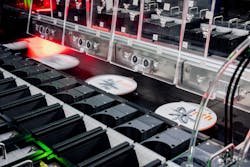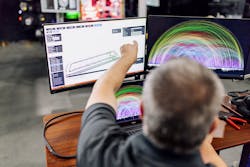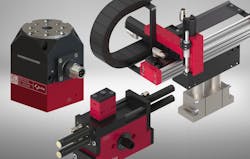Levitation is a term most often used to describe the motion of space aliens and spiritual phenomena. But not at Automation NTH, a custom builder of complex automation systems, where the term refers to the motion generated by the magnetic-levitation (maglev) material handling system in the company’s new, flexible assembly machine that fills, inspects and seals disposable blood test kits used by medical laboratories.
In this system, a mover holds one of three versions of the workpiece as it floats on a magnetic field, taking the workpiece to the appropriate stations. Once a robot places a kit on one of the system’s 18 independently controlled movers, the mover levitates and rotates 360 degrees for inspection by a vision system. Then, the mover carries the test kit to the dispensing station specified in the kit’s recipe.
At each station, the mover tilts and rotates the floating mover to present the correct filling location on the kit to the dispensing head. More vision inspections occur at the process midpoint and at the end, where a reel feeder seals the test kit with an adhesive plastic cap with ±30-micron repeatability. Then, the mover goes to the final station for offloading.
Maglev systems like this one are just one example of advanced motion control technology finding its way into assembly automation. This and other developments in actuators, sensors and controls are significantly improving the efficiency, flexibility and reliability of assembly automation.
“The landscape of motion control has undergone a remarkable transformation in recent years,” said Rick Simer, senior technology field manager at SEW Eurodrive. “At the heart of this evolution, we’re seeing unprecedented advancements across multiple interconnected technologies that work together to create increasingly complex automation systems.”
How maglev changes the automated assembly process
Of the various technologies available to automate its client’s manual filling, inspection and sealing process, Automation NTH chose a material handling system based on a maglev system called XPlanar from Beckhoff Automation. The decision was driven by two constraints: the need to work in a temperature and humidity-controlled cleanroom and the desire to fill the test kits in random order, according to the recipe for the blood test that a kit will perform. The various recipes are mixed from the more than 40 reagents the machine is capable of dispensing.
Driving the choice for a maglev option included issues such as available floor space in cleanrooms and the expense associated with the flexibility required to fill kits in random order using traditional automation technologies.
“Moving the dispensing heads to the product with conveyors, robotics or other material-handling technologies would have created massive price and space requirements,” said Peter Sarvey, head of sales at Automation NTH. This reality helped the company realize “we should move the product, not the dispensing heads,” he said.
Beyond cost issues, there’s also the fact of how conventional indexing systems work. During each cycle, these systems index all workpieces simultaneously among evenly spaced workstations. That means that “the cycle time is dictated by the station with the slowest process,” explained Jeff Johnson, mechatronics product manager at Beckhoff Automation.
That’s not the case with newer mechatronic systems like the XPlanar. The movers in these systems are decoupled from the assembly process and move independently of each other. “This allows for parts to be transferred dynamically between stations during the assembly process,” said Johnson. “Movers can bypass stations and other movers for lot-size-one production.”
The automation tech sought by Automation NTH also needed to move the workpieces smoothly and support environmental controls because the reagents being carried are sensitive to humidity, temperature and movement.
“It’s not just about flexibility and space savings, but also maintaining the formulation’s integrity,” said Molly Blazek, Automation NTH’s director of strategic accounts. “The smoothness of XPlanar’s motion and the cooling system Beckhoff offers all played into the compatibility with the customer’s product.”
Incorporating maglev actuation into the design of the system shortened the five-minute cycle time for the old manual process to just five seconds per test kit. Blazek also noted that XPlanar required a smaller power supply than competitive systems, which reduced heat generation.
These results convinced the design team at Automation NTH to consider using XPlanar maglev actuation in the future. “The ability to manipulate the part, as opposed to moving the application tooling, provides a tremendous design advantage,” said Sarvey. “For parts with more than two or three units of operation at various locations on the part, rotating and manipulating the part on the XPlanar mover is a gamechanger.”
Controller, actuator and sensor advances expand motion control capabilities
Beyond maglev developments in assembly operations, there is also increasing integration of advanced technologies in other actuator types, as well as in motion control systems’ controllers and sensors.
In the realm of actuators, SEW Eurodrive’s Simer pointed to integrated direct-drive technology that can deliver precision motion at a level that was once thought impossible. “Servomotors have evolved to offer enhanced torque density and position control that would have seemed like science fiction a decade ago,” he said. “Perhaps most exciting is the emergence of integrated servomotors, where drive electronics are combined within the motor housing.”
Automation vendors are also integrating controls into actuators. “Modern actuators, such as the SREH from Afag Engineering, now have integrated controllers and support industrial communication protocols like IO-Link,” said Florent Orget, product marketing manager for actuators at Emerson Discrete Automation. “This decentralized design reduces the need for extensive wiring and the space required in electrical cabinets.”
This integration of controls on actuators has also allowed automation vendors to build in process-monitoring capabilities that can contribute to control operations via IO-Link and transmit data in real time to edge devices.
In addition to integrated controls, controller technology has been experiencing a renaissance. “Today’s controllers handle complex multi-axis coordination with microsecond-level precision thanks to advanced algorithms and real-time processing,” added Simer.
Of course, software is another key element behind the advance of motion control tech. “Motion-control software now offers intuitive graphical interfaces for complex motion programming, real-time monitoring and advanced diagnostics,” said Simer.
Advanced software like physics-based modelers and digital twin technology help engineers validate motion sequences and identify problems before physical implementation.
And then there’s the increasing addition of smart sensors into actuators. “Sensor technology has blossomed into a sophisticated ecosystem,” noted Simer. “Smart sensors now incorporate onboard processing, high-resolution absolute encoders have eliminated the need for time-consuming homing procedures and advanced force sensors bring unprecedented precision to assembly operations.”
Another advanced sensor application includes the embedding of vibration sensors into the spindle drives on actuators. “By monitoring critical parameters, these systems can detect potential issues early, reducing unplanned downtime and extending the lifespan of the equipment,” said Emerson’s Orget.
The growing impact of AI and edge technologies on motion control
Artificial intelligence (AI) and edge computing are two emerging technologies that hold great promise for supporting and enhancing motion control for assembly automation.
Of the two, AI has attracted the bulk of attention over the past few years. When it comes to motion control, however, Eric Falasco, product manager of linear technology at Bosch Rexroth, thinks that assembly machine OEMs should implement AI in phases to gain experience with the technology before fully deploying it. “We have a lot to learn about AI, just like we do with any new technology,” he said. “It can certainly improve motion control technologies, but there will be a learning curve. So, we shouldn’t rely 100% on it for motion control right away.”
An initial niche for AI in motion control is predictive maintenance. Here, pattern recognition algorithms are key. “AI-driven predictive maintenance systems analyze vast amounts of sensor data to predict potential failures before they occur,” explained Simer.
“Knowing weeks or even months in advance when a component will wear out allows you to order and receive a replacement before the current one fails,” added Falasco. Plus, it allows scheduling a convenient time to replace it to avoid downtime that causes disruptions and supply chain delays.
Besides helping with predictive maintenance, AI is also finding application in adaptive learning. “Machine learning algorithms now optimize motion parameters in real-time, adapting to changing conditions and improving system performance over time,” said Simer. This kind of learning allows robots and other motion systems to learn and improve their performance through experience.
“These technologies could revolutionize predictive maintenance by analyzing the health of components in real-time and adjusting settings as needed to prevent failures,” added Orget. “As AI continues to evolve, we can expect significant advancements in how machines learn, adapt and improve overall efficiency.”
This ability carries over to configuring actuators and other components to assist in their installation and commissioning. “Components with self-learning and self-optimizing capabilities, for instance, require less in-depth technical knowledge from users and significantly reduce the learning curve,” said Orget.
To ease the installation of new components, AI often works hand-in-glove with edge computing. “This technology enables the direct transfer of data to edge gateways,” noted Orget. “It is already well established in machine automation.”
“By processing data closer to the source,” Simer noted that “edge computing reduces latency in motion control operations and improves system reliability through distributed processing.”
Consequently, many OEMs are exploiting this ability to relieve the main PLC of some data processing duties, thereby reducing the load on the controller and preventing unnecessary delays in cycle times. “More and more machine builders are striving for real-time controlled processes,” said Orget. “Shifting some of the processing away from the main PLC is becoming essential for optimizing performance and minimizing delays.”
It also streamlines the integration of computing-intensive technologies, like vision systems. “High-speed cameras with advanced image processing now guide motion-control systems in real-time, enabling dynamic path correction and adaptive motion control,” said Simer. “3D vision systems provide depth perception for complex assembly tasks, and AI-enhanced vision processing enables complex pattern recognition and defect detection.”
More motion control coverage from Automation World:
Leaders relevant to this article:






